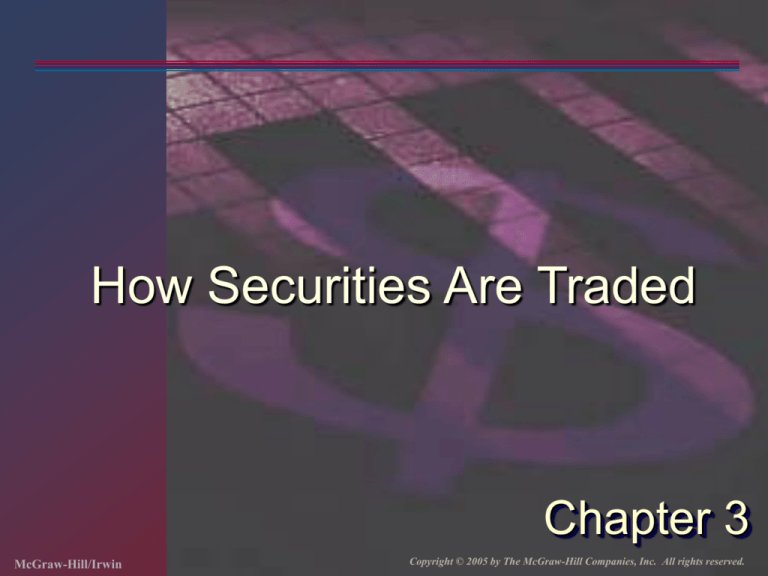
How Securities Are Traded
Chapter 3
McGraw-Hill/Irwin
Copyright © 2005 by The McGraw-Hill Companies, Inc. All rights reserved.
Primary vs. Secondary Security Sales
Primary
New issue
Key factor: issuer receives the proceeds
from the sale.
Secondary
Existing owner sells to another party.
Issuing firm doesn’t receive proceeds and
is not directly involved.
3-2
Investment Banking Arrangements
Underwritten vs. Best Efforts
Underwritten: firm commitment on
proceeds to the issuing firm.
Best Efforts: no firm commitment.
Negotiated vs. Competitive Bid
Negotiated: issuing firm negotiates terms
with investment banker.
Competitive bid: issuer structures the
offering and secures bids.
3-3
Public Offerings
Public offerings: registered with the
SEC and sale is made to the investing
public.
Shelf registration (Rule 415, since 1982)
Initial Public Offerings (IPOs)
Evidence of underpricing
Performance
3-4
Private Placements
Private placement: sale to a limited
number of sophisticated investors not
requiring the protection of registration.
Dominated by institutions.
Very active market for debt securities.
Not active for stock offerings.
3-5
Organization of Secondary Markets
Organized exchanges
OTC market
Third market
Fourth market
3-6
Organized Exchanges
Auction markets with centralized order
flow.
Dealership function: can be competitive
or assigned by the exchange
(Specialists).
Securities: stock, futures contracts,
options, and to a lesser extent, bonds.
Examples: NYSE, AMEX, Regionals,
CBOE.
3-7
OTC Market
Dealer market without centralized order
flow.
NASDAQ: largest organized stock
market for OTC trading; information
system for individuals, brokers and
dealers.
Securities: stocks, bonds and some
derivatives.
Most secondary bonds transactions
3-8
Third Market
Trading of listed securities away from
the exchange.
Institutional market: to facilitate trades
of larger blocks of securities.
Involves services of dealers and brokers
3-9
Fourth Market
Institutions trading directly with
institutions
No middleman involved in the
transaction
Organized information and trading
systems
ECN Development
3-10
International Market Structures
London Stock Exchange
Dealer market similar to NASDAQ
Stock Exchange Automated Quotation
Greater Anonymity
Tokyo Stock Exchange
No market making service
Sartori provides bookkeeping service
Feature a floor and electronic trading
Global Market Alliances
3-11
Costs of Trading
Commission: fee paid to broker for
making the transaction
Spread: cost of trading with dealer
Bid: price dealer will buy from you
Ask: price dealer will sell to you
Spread: ask - bid
Combination: on some trades both are
paid
3-12
Types of Orders
Instructions to the brokers on how to
complete the order
Market
Limit
Stop loss
3-13
Margin Trading
Using only a portion of the proceeds for
an investment.
Borrow remaining component.
Margin arrangements differ for stocks
and futures.
3-14
Stock Margin Trading
Maximum margin
Currently 50%
Set by the Fed
Maintenance margin
Minimum level the equity margin can be
Margin call
Call for more equity funds
3-15
Margin Trading - Initial Conditions
X Corp
$70
50%
Initial Margin
40%
Maintenance Margin
1000
Shares Purchased
Initial Position
Stock $70,000 Borrowed
$35,000
Equity
$35,000
3-16
Margin Trading - Maintenance Margin
Stock price falls to $60 per share
New Position
Stock $60,000 Borrowed
$35,000
Equity
$25,000
Margin% = $25,000/$60,000 = 41.67%
3-17
Margin Trading - Margin Call
How far can the stock price fall before a
margin call?
(1000P - $35,000)* / 1000P = 40%
P = $58.33
* 1000P - Amount Borrowed = Equity
3-18
Short Sales
Purpose: to profit from a decline in the price
of a stock or security.
Mechanics
Borrow stock through a dealer.
Sell it and deposit proceeds and margin in an
account.
Closing out the position: buy the stock and
return to the party from which it was
borrowed.
3-19
Short Sale - Initial Conditions
Z Corp
50%
30%
$100
100 Shares
Initial Margin
Maintenance Margin
Initial Price
Sale Proceeds $10,000
Margin & Equity
5,000
Stock Owed
10,000
3-20
Short Sale - Maintenance Margin
Stock Price Rises to $110
Sale Proceeds
$10,000
Initial Margin
5,000
Stock Owed
11,000
Net Equity
4,000
Margin % (4000/11000)
36%
3-21
Short Sale - Margin Call
How much can the stock price rise before a
margin call?
($15,000* - 100P) / (100P) = 30%
P = $115.38
* Initial margin plus sale proceeds
3-22
Regulation of Securities Markets
Government Regulation
Self-Regulation
Circuit Breakers
Insider Trading
ECNs and Fragmentation
3-23









